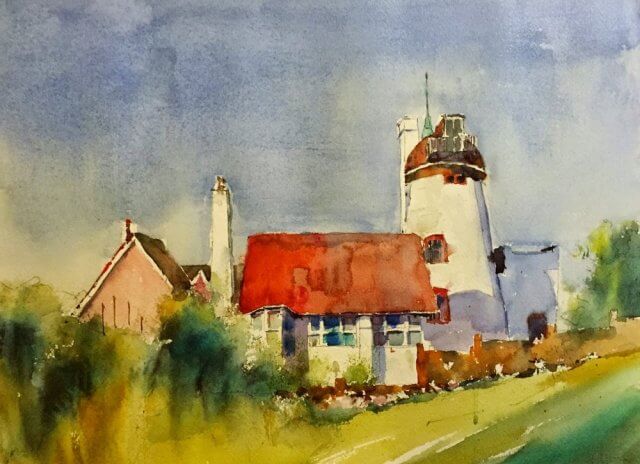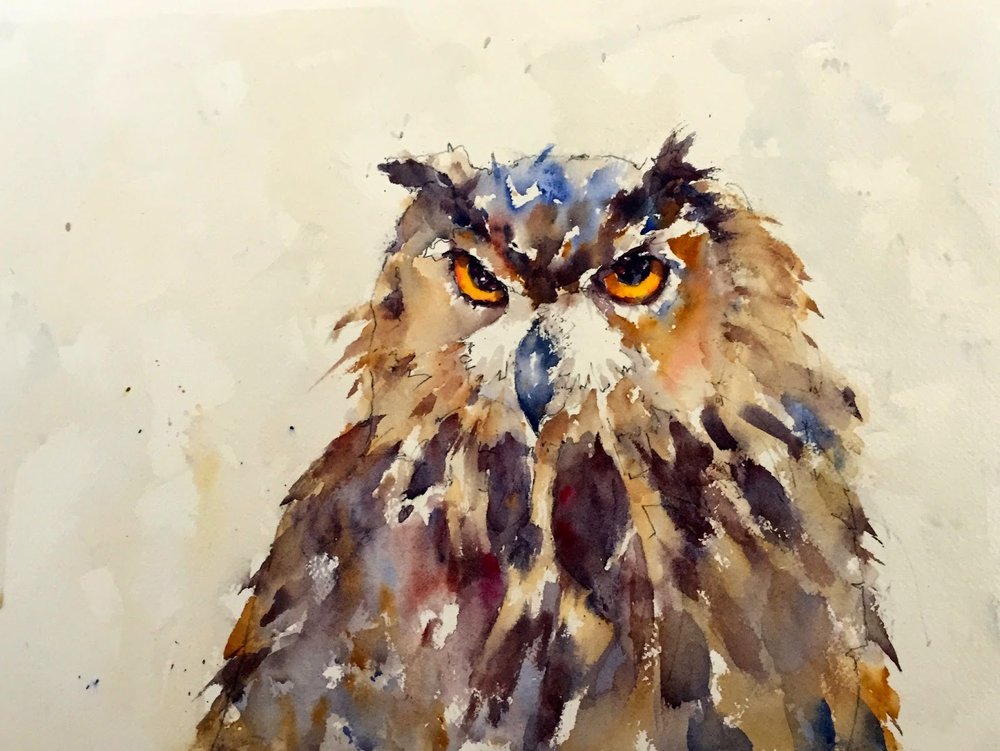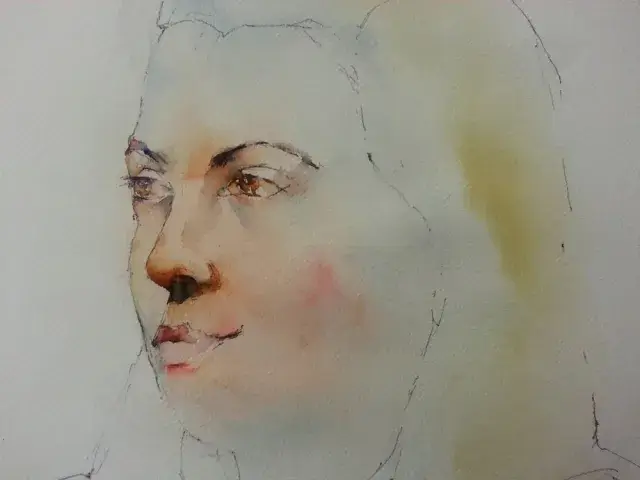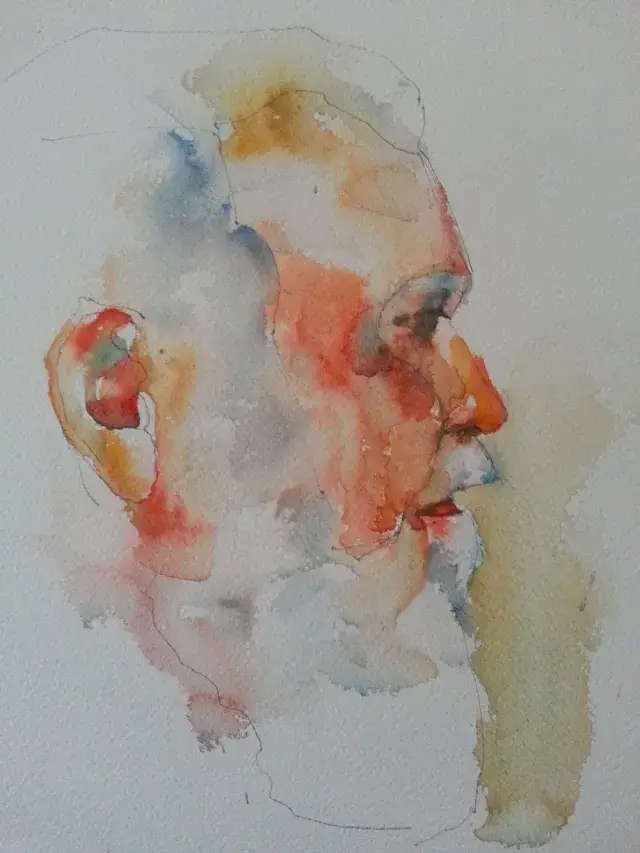This subject is the old mill in Aldeburgh and the reference came from paintmyphoto.com. I thoroughly enjoyed doing this one. I even don’t mind the bleeds and the patchy sky. I combined things I’ve learned from Charles Reid and John Lovett. I used the local color darks first Reid approach for the building and the rough brush Lovett approach for the trees. I think it came out rather well.
Author: Michele Clamp
Owl Watercolor Revisited
I have a love/hate relationship with painting owls. I find them very difficult (and secretly think they’re a bit cheesy) but can’t stop painting them. Here is my latest effort and I’m actually pretty pleased.
Intermediate pictures below.

Starting the painting. Went straight in with the eyes as I would for a person portrait. Mostly ultramarine, burnt sienna and raw sienna.

Close up of the eyes. Was careful to modulate the tones in the pupils so not to make them like little black holes. Also tried for some subtle tone on the central white feathery bit (this must have a proper name no?).

Finished owl. The body feathers are looking better now there’s some tone in the lighter regions. Decided on a very subtle background just to take the white off the paper. With such a limited palette in the owl itself I thought putting a contrasting colour in the background would detract from it.
Below are a couple of preliminary sketches I did to warm up and should be a lesson in how I should never miss this step out. The first is truly awful – proportions are wrong, the eyes are generic ‘eye’ shape, generally dreadful.

Charles Reid Workshop – Day 3, Still Life
Results of day 3 – I’m pretty chuffed with this. No Charlie the seagull though.
Full story :
Day 3 – still life day. And there was his seagullness himself. And doesn’t he look fine?
So today was flowers, fruit and stuff. I’ve been looking forward to this one especially (and not just for the seagulls). Flowers are not my favorite things to paint, mainly because I’m crap at them so I was all eyes and ears to see how Mr Reid went about things.
btw – this was my view from the back row. This would be pretty useless apart from the fact I’d bought some small binoculars with me. They are fantastic! It’s like being 6 inches from the paper. You can keep your front row seats.
Anyway – on with the demo. First the drawing as usual. He was using a different paper today – Schut paper. This is dutch and not widely available in the US. It’s not cheap – about twice the prices of Arches – and it has the distinction of being Judy Reid’s favorite paper. Apparently it is very absorbent so doesn’t allow much lifting or reworking which isn’t a problem with Mr R’s technique. It also has an interesting texture. It’s supposedly rough but it didn’t look like the usual rough texture which has a pronounced tooth to it. The tooth was less pronounced and coarser grained which allows for interesting brushwork without feeling like you’re painting on a brick (something which Mr R. said about Arches 300lb rough. Chortle!)
There wasn’t as much description going on today as there was with the figure painting and Mr R pretty much just got on with it. First there was 30 minutes of contour drawing. Emphasis on drawing connected objects, joining shadows to objects and giving as much, or more, emphasis to the inside shapes of things.
The setup – with seagull. Mr Reid is a big fan of a non-arranged arrangement and likes to paint things that look as though they’ve just been left there. He also likes things that just happen to be at hand – hence the paint brushes and tubes and the Edward Hopper book.
An action photo. He sits very close to the subject and very low down. This gives his figure paintings a distinctive look – the model is above eye-level with a good view of the nostrils and a relatively small head due to the perspective. For the still lives this effect is less pronounced.
Towards the end of the first 30 minutes of painting. Everything is pretty much painted just once and left. He leaves a lot of white space which certainly isn’t evident in the photo but gives a liveliness to the painting. He’s also extremely careful about where he places his darks. For white flowers the dark leaves a pretty much all that defines their boundaries. Similarly he treats his edges with great care – which ones to keep sharp and which ones to keep soft to just give an impression.
You can just about see the effect of the Schut paper here. In the lighter areas you can see the coarse soft tooth – it gives a mottled finish to the paint. you can also see the amount of white space he’s left in the foliage.
Here we are almost finished. He got rather grumpy at this point. The art center is having some renovations done in the basement and they were putting up drywall. This apparently involves the use of a tool that sounds like chairs scraping across floorboards every 5 seconds and gets really annoying. About 5 minutes after this Mr R. got up and refused to do any more. Don’t blame him really – it was very annoying.
The finished painting (completed after the drywallers had gone to lunch). And very nice it is too.
Critique Time
Each of us had a critique of one of our paintings over lunch. He was very kind to everyone but not to the point of abject flattery. If your painting has a person with a head that’s five times the size of their feet he will point this out as probably not the best feature of the painting. But we don’t really need to be told that.
Now it’s our turn
So – on to the still life. There were 6 different ones set up around the room. I wanted Charlie the seagull but the front row people had the first choice so I didn’t get the chance. I did want an arrangement with a lot of white flowers however so I plumped for the one below. I was sharing this with other people and they decided they wanted to clump all the fruit together. I really didn’t want this – I wanted the scattered approach with different objects linked by shadows. I snuck in the lemon and lime on the right hand side and chose to ignore the squash things.
The drawing – I’m usually pretty happy at this stage. This took around 30 minutes to do.
The start of the painting – probably after around 45 minutes. This was an extremely difficult painting to do and I concentrated extremely hard. I usually finish a painting in well under two hours but this was close on a 3 hour job and I hadn’t really finished then.
Having said that I really learned a lot in this afternoon’s session. It felt like putting a puzzle together. Where do I place the leaves to make sure the flowers stand out? Where should I have sharp edges to the flowers and where should I leave things soft? Where do I put broad strokes and where to put detailed ones?

The finished piece. (There are a couple of gaps but I ran out of time). This is a huge improvement over my previous flower pictures.
Oh – Charles patted me on the shoulder and said ‘beautiful painting’. <Blush>
Finally some action shots of all of us at work. I think everyone had a pretty successful afternoon.
Right – I’m off for a well deserved Ruby Murray courtesy of Falmouth’s finest Indian establishment.
Charles Reid Workshop – Day 1
My results on day 1 – the full story is below.
Arrival at the Falmouth Art Center
So the day finally arrived for the Charles Reid watercolor workshop. Boris the mini car was loaded up and at 8am off we went to Falmouth Art Center.
I was almost the first there – we wondered whether we’d have to paint the ladder but it was only there to adjust the lighting. The Center is impressive – large and airy and obviously quite new or at least newly renovated.
Meeting Charles and Judy Reid
After coffee and complimentary bagels Judy and Charles arrived. Judy is obviously the organizer and keeps everyone informed as to what is going on. She shuffled us around a bit so we could all see while Charles settled himself in his chair in front of his easel.
Starting the Portrait – the Drawing
Our model (Katrina – like the hurricane) sat in 15-20 minute chunks while Charles drew and explained what was going on. Having read his books and watched several of his videos the information wasn’t completely new but there’s nothing like actually seeing someone draw and paint who knows how to do it.
He went surprisingly slowly – this was after the first 15 minute section with just a rough outline of the head and more detail of the nose and mouth.
Charles Reid starts the Painting
This was after 30 minutes – most of the time was spent on the features with the hair and shoulders put in in a couple of minutes or so. Looking closely at the drawing there are surprisingly few lines. He strongly urges us not to ‘sketch’ with multiple feathery strokes but put down decisive lines. Even so the sparseness of the drawing was surprising.
The time went incredibly quickly. I thought only 5 minutes had gone by when the buzzer for the first 15 was up. Amazing how absorbing watching someone else draw is 🙂
Charles puts in a light underwash
Finally onto the painting. After saying that he usually doesn’t do an underwash he proceeded to do just that. I can’t remember the rationale but it doesn’t really matter. He used cadmium red, raw sienna and cerulean blue and a fairly large number 14 brush to put some warmth into the face and some color into the hair and sweater. With these washes he didn’t keep to the outline but pushed the washes into the surrounding areas.
Painting the Features in a darker mix
After another break and when the wash was dry it was straight into painting the features. He said he usually starts painting at the same place he starts drawing. In this case it was the nose and mouth but in other cases it could be the eyes. He was careful to stress that there was very little water in his mixes and it was interesting to see how he got value changes.
He started by putting in the cast shadow under the nose in a dark mix of cad red, cerulean and raw sienna. Then he took a slightly damp brush and pulled the paint out into the other areas of the nose and face. This enables him to get unified color but also a good range of light to dark.
He paints as he draws – extremely slowly and carefully. The nose and mouth stage above took another 20 minutes. As with the drawing he stressed that we shouldn’t follow the outline but leave gaps and soft edges to indicate form.
The next two parts were the eyes and then the planes of the face. For the eyes he went straight in with the dark of the lashes and the iris. The iris he put in in small dots and leaving some white of the paper. Then he goes back in with a clean damp brush and softens areas by pulling out the pigment. Interestingly the white of the eye he put in as quite a strong raw sienna. It looked out of place when it went down but looked fine when the rest was filled in.
The side of the face he put in with an extremely strong and apparently dark mix. Again this dried much lighter (although I’m not sure it was completely successful).
Finally the hair and the sweater was put in. This was done comparatively quickly and he made good use of his fingernails to scrape out the light regions.
Not bad huh?
Then it was our turn – my version
After lunch an extra model arrived and half of us sat in front of her and half in front of Katrina again. I chose Katrina as I wanted to put into practice the advice Charles had given us in the morning. It took the first twenty minutes to do the drawing. I felt reasonably happy at this stage.
Oh and Charles’ comment – ‘Good drawing’ 🙂
After the underwashes as he had done it was time to start on the features. I felt that I was working extremely tentatively and would have liked some stronger color but the features came out pretty well.
It’s probably hard to tell the difference between this and the previous version. I was getting a bit jittery and didn’t want to muck anything up. I did strengthen and warm up the shadow underneath the nose as well as add some subtle washes to give form to the nose and brow area. The eyes I was pretty happy with. I tried to follow Charles’ advice to put the iris in with dots and leave white space. I think it works well.
At the previous stage Charles came round and said that I should leave it pretty much as it was. I should leave out the hair and sweater and even the shadow on the side of the face. He did suggest putting some color into the cheeks and calling it finished. Which I did.
I was then at a bit of a loose end and there was about an hour to go so I started a fresh painting aiming to put in some bolder color and have a go at the hair. For a quick rendition I was pretty happy.
So that was day one. I enjoyed every minute of it.
Charles Reid – Watercolor Solutions Exercise
A bit more practice before next weeks course. I’m doing everything by the book – careful contour drawing, clean palette with no puddle colors, mixing mostly on the paper and not on the palette. I’m consciously using much brighter colors than I would usually (on Mr Reid’s recommendation) and I think it’s paying off.
Bristle Brush Watercolor Painting with John Lovett
So Santa brought me a John Lovett Splashing Paint DVD this year and by golly is it good. Lots of ideas and advice and just seeing him put paint to paper is educational. In particular it was good to see his use of a tatty old bristle brush to give wonderful ragged brush marks. I dug out an old acrylic brush to try the same and I’m pretty happy with the results.
John Lovett is One of My Favorite Artists
When I first started painting in watercolor John Lovett quickly became one of my favorite watercolor artists. He has a great website and his videos taught me a lot. John Lovett paintings have a unique quality to them that I love to this day. In particular he integrates watercolor with other media such as inks and gouache and gesso to create beautiful atmospheric effects. I actually managed to snag a John Lovett watercolor at auction and it now hangs in my office. Makes me happy every time I look at it.
Different Tools can be Freeing
On the whole it is good to use the same set of brushes regularly. You get to know how they handle, how much water they hold, and just how the weight of them feels in your hand. But sometimes trying something completely new takes you in a slightly different direction. I’ve now bought a few of these 1/2″ bristle brushes and really like them when some irregular, organic brushwork is needed. In fact I’ve taken some scissors to a couple of them and made them even more tufty and irregular. This gives an even more unpredictable effect on the paper which I really like.
Bristle Brush Watercolor Painting is good for Trees
I find them mostly useful on organic things like trees and bushes. And sometimes skies if some wispy clouds are needed. For other things like buildings or portraits I wouldn’t reach for these as a matter of course. But then maybe that’s the kind of thing we should be doing. Something outside our usual routine. Maybe it’s worth a shot!
The Best Thing About Bristle Brushes!
The best thing about bristle brushes is they’re so cheap. Even if they get worn they still work well as we don’t mind a bit of wear and tear. Buy them at the hardware store – they’re only a couple of bucks.

Online Zoom Classes
I run online zoom courses regularly for both beginners and more advanced students. Please check out my workshop page.
John Lovett Exercise – Landscape

I was rooting around on the bookshelf this morning and came across one of my favorite watercolor books: John Lovett’s Textures, Techniques and Special Effects for Watercolor. There are a couple of John Lovett artist books. The other one is this:
As the title suggests it’s a getting started book. It’s a great book and has some interesting subjects but I do prefer the slightly more advanced ‘Textures, Techniques and special Effects for Watercolor’. This seems to be out of print sadly so I’m glad I held onto my copy.

Now I think the title is a bit misleading as it’s a first rate instruction book for watercolor full stop. Never mind the special effects. As i was feeling a little jaded I thought I’d start at the beginning and go straight through the book doing all the exercises. It’ll keep me in practice but without troubling the brain cells too much and frankly it’s too hot for the brain cells to do anything anyway.
John Lovett Landscape: – Start with a Loose Drawing

No problem here. Trying to keep the shapes interesting and uneven without sacrificing what the subject it.
Next the sky wash
Yeah. This was meant to be an even wash over the whole sky and I screwed this up royally. I should have my watercolorist badge stripped from me for this. But never mind. Onwards.
Paint the Foreground with Light Washes

Light washes over the foreground to indicate some foliage and a little detail around the road (or is it a river?). Remembered to keep things pretty light and used my 1/2″ bristle brush to keep the edges scruffy. Pretty happy so far.

Background Hills in a Purplish Blue
Distant hills in a slightly greyed purple. Nothing fancy here and it’ll be mostly covered by trees anyway.
Trees with the Bristle Brush
Now the trees. It’s amazing how hard I have to try to keep the trees uneven. It’s almost as if the brush has a will of its own and physically resists me. I’m also building up the foreground a little here – again with the 1/2″ bristle brush.
Final Details – Houses and Fences
We’re actually almost there now. Amazing how quickly things come together. A little shadow detail on the houses followed by some dark doors and windows. The foreground has yet another layer of detail. This time some red for interest and some dark lines for fences/grass.

The only remaining thing was to *very* delicately put in some white lines for branches in the trees. So easy to ruin everything here with some clumsy marks so less is more.
(Note: As an Amazon Associate I earn from qualifying purchases. I get commissions for purchases made through links in this post. I never recommend anything I don’t personally recommend or use regularly.)















































